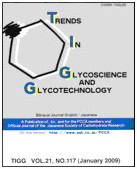All issues

Volume 21 (2009)
- Issue 122 Pages 309-
- Issue 121 Pages 255-
- Issue 120 Pages 197-
- Issue 119 Pages 131-
- Issue 118 Pages 49-
- Issue 117 Pages 1-
Volume 21, Issue 121
Displaying 1-5 of 5 articles from this issue
- |<
- <
- 1
- >
- >|
MINIREVIEW
-
Tadanobu Takahashi, Takashi Suzuki2009 Volume 21 Issue 121 Pages 255-265
Published: 2009
Released on J-STAGE: February 18, 2010
JOURNAL FREE ACCESSA sulfated glycolipid, 3-O-sulfogalactosylceramide (sulfatide), is ubiquitously present in various tissues such as the brain, kidney, respiratory tract and gastrointestinal tract. The metabolism of sulfatide, which synthesized by two transferases (ceramide galactosyltransferase and cerebroside sulfotransferase) from ceramide and specifically degraded by a sulfatase (arylsulfatase A), is very simple compared to that of many gangliosides. Sulfatide is a biologically multifunctional glycolipid involved in the nervous system, diabetes, the immune system, hemostasis/ thrombosis, bacterial infection and virus infection. We found that sulfatide promotes translocation of newly synthesized ribonucleoprotein complexes of influenza A virus from the nucleus to cytoplasm and progeny virus production by association with a viral surface glycoprotein, hemagglutinin, delivered to the cell surface. In this review, we describe the role of sulfatide in infection with viruses, including influenza A virus.
View full abstractDownload PDF (935K) -
Akihiro Ishiwata, Yukishige Ito2009 Volume 21 Issue 121 Pages 266-289
Published: 2009
Released on J-STAGE: February 18, 2010
JOURNAL FREE ACCESSGlycosylations have been used repeatedly as the key reaction in the synthesis of oligosaccharides and polysaccharides, therefore both of efficiency and stereoselectivity of the glycosylations are important. There has been reported the construction of 1,2-cis glycoside found in various bioactive glycoconjugate glycans from eukaryotes as well as prokaryotes, although a few for the definite methodologies to construct stereoselectively. Approaching from both efficiency and stereoselectivity of the reactions, we developed various highly efficient and stereocontrolled O-glycosylation methodologies for the construction of 1,2-cis glycosides. We also showed that their 1,2-cis glycosylation methodologies have been applied to the stereoselective synthesis of various bacterial glycoconjugate glycans.
View full abstractDownload PDF (2336K) -
Tadashi Yamashita2009 Volume 21 Issue 121 Pages 290-301
Published: 2009
Released on J-STAGE: February 18, 2010
JOURNAL FREE ACCESSGlycosphingolipids (GSLs) are present on virtually all mammalian cell plasma membranes and intracellular membrane structures. Typical structures on cell membranes are the so-called raft and caveola domains, which contain large amounts of sphingolipids and cholesterol. Many types of receptors for intercellular signal transducers, such as GPI-anchored proteins, reside on the exoplasmic face of the rafts/caveolae, whereas Src family kinases are located on the cytosolic face. Thus, GSLs play a role in transmembrane signal transduction. However, using knockout mice, it has also been established that GSLs are essential molecules for mouse early-stage development, and that they play significant roles in signal transduction, immunological reactions, and brain function.
View full abstractDownload PDF (762K)
GLYCOTOPICS
-
Shinya Hanashima2009 Volume 21 Issue 121 Pages 302-304
Published: 2009
Released on J-STAGE: February 18, 2010
JOURNAL FREE ACCESSDownload PDF (177K) -
Kiichiro Totani2009 Volume 21 Issue 121 Pages 305-307
Published: 2009
Released on J-STAGE: February 18, 2010
JOURNAL FREE ACCESSDownload PDF (191K)
- |<
- <
- 1
- >
- >|